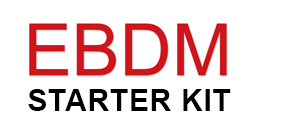EBDM Starter Kit
4b: Equipping Stakeholders to Apply Research Evidence
Navigating the Roadmap

Activity 4: Understand and have the capacity to implement evidence-based practices.
Introduction
A justice system that seeks to use evidence to guide decisions must have as its foundation a group of professionals (both policymakers and practitioners) who share a core base of knowledge about evidence-based practices and an appreciation for the usefulness of research to system, agency, and case-level decision making.
While agencies/individual professional groups necessarily promote knowledge and skill development that is unique to their disciplines (e.g., firearm instruction for law enforcement, interpretation of law for lawyers, safety practices for correctional staff), the research around evidence-based practices as it relates to risk and harm reduction is applicable to, and crosses, all disciplines. So too is the practice of using research to inform decisions—regardless of field or specific decision point.
These common areas of knowledge and the practice of applying research to decision making comprise a core EBP training curriculum and strategy that is appropriate for all justice system professionals. A core, systemwide evidence-based training strategy has several benefits. It
Developing a Learning Culture
Justice systems become learning cultures when they grow dependent on information, particularly empirically derived information. Policy debates that once centered on philosophical beliefs or one’s personal experiences are quite different when the core of the discussion is based on what the evidence does or does not suggest. Individual case decisions that are guided by science rather than intuition or past experience often result in different actions and, fortunately, better outcomes. Learning cultures begin with a common base of knowledge and an appreciation for science.
- promotes the notion that criminal justice professionals are each an important part of a system, rather than operating in individual “silos” that have little bearing on one another;
- opens lines of communication by creating a common language across discipline groups;
- provides an opportunity for an open exchange of ideas, airing of concerns, and joint problem solving; and
- creates a culture of knowledge development and growth—a learning system—whereby knowledge acquisition and its application are encouraged and reinforced. To this end, training and knowledge development is a dynamic process. It does not occur once or for one period of time and then come to an end. As systems grow and evolve, as new staff are hired, as experiences are acquired, and as new research emerges, learning cultures grow and evolve too.
Purpose
To equip professionals across the justice system with a core base of evidence-based knowledge and an appreciation for the application of research evidence to their decision making.
Participants
The policy team will ultimately take the lead in developing and delivering a core EBP training curriculum to local stakeholders. However, other staff may be brought in as needed (to assist with surveying, curriculum development, training, etc.).
Instructions
- Assess training needs and develop a knowledge baseline.The first step in developing and delivering a core EBP training curriculum is to assess knowledge regarding evidence-based practices across professional staff in all justice system agencies. This can be done fairly efficiently through the use of a brief survey or some other structured or semi-structured method.1 The survey results will provide aggregated baseline data for each responding agency.2
- Review the knowledge survey results, identify information gaps, and build training plans. The results of the knowledge survey will provide clear and specific information about training needs across the system and within each discipline. This information should be used to guide the development of a systemwide training strategy and to inform agency-specific knowledge development efforts.
- In building a training strategy, keep in mind that although professionals across the system have a common need for core information, some will require more in-depth knowledge of some subjects while others may not.
- Also keep in mind that, in many areas, understanding the research and applying it requires the development of new skills. Skill-development training is quite different from knowledge-development training. It typically requires more time and always requires the opportunity to practice new strategies and techniques and receive feedback on the application of the new skills. The appendix illustrates some of the core EBP research topics and the stakeholder groups for whom each topic might be most relevant. Items in red are knowledge-based training objectives, while items in gray are skill-based training objectives.
- Customize the training to meet individual agency, as well as jurisdictional, needs. Development of a training strategy should take into account several questions:
- Should training delivery be directed to a single audience (e.g., judges), should it be directed to partially mixed audiences (e.g., judges, prosecutors, defenders), or should it be fully multidisciplinary? There are pros and cons to each choice. Keep in mind that when a core set of messages or base of knowledge is delivered, it is often beneficial for all stakeholders to receive this information at the same time. This helps support the goal of cross-agency collaboration.
- Should training be delivered by local staff/experts, external experts, or some combination of these? There are also pros and cons to each of these options. Regardless of the choice made, ensure that the selected trainers have sufficient knowledge and credibility with respect to the training topics that they will be received favorably by the audience.
- Should training cover basic information, advanced information, or both? The training needs assessment is likely to uncover some “unevenness” in the needs of cross-agency groups and within single-agency groups. Determining how to address individual needs within the context of a large number of potential trainees will be an important point to consider. Regardless of the final methods selected, be careful to avoid a “one size fits all” approach by assuming that what is right for one group will be right for all. It may be advisable to develop a customized needs approach—within the overall context of what is possible—by engaging the various stakeholder groups in discussions around how best to meet their needs.
- Conduct the training and then elicit feedback. Plan for the collection of post-training feedback prior to the training event. This could be in the form of re-administering the knowledge survey to determine if knowledge gaps were lessened (see below), an open discussion about the gaps filled by the training or lingering questions, and/or a written follow-up survey to determine if participants believe that the training goals were met and/or whether they identify additional training needs and, if so, which ones. Regardless of the method selected, feedback from the training will help determine where additional or more targeted training is needed. These needs should be incorporated into the systemwide training strategy.
- Re-administer the knowledge survey following the delivery of core EBP training material and compare the results with those of the initial survey to determine if knowledge levels improved sufficiently or if additional training is necessary. Then develop a “next stage” training plan, as needed.
- Identify methods to assess evidence-based knowledge over time and continue to build an ongoing, systemwide training strategy.
1 See 4a: Understanding Your Agency: Conducting an EBP Knowledge Survey for one example of a tool that can be used.
2 See Appendix 1 for an illustration.
Example
Knowledge Survey Summary Report from One County
Appendix
Targeting Core EBP Knowledge Areas to Individual Stakeholder Groups
PDF/Printer Friendly Version of Section

